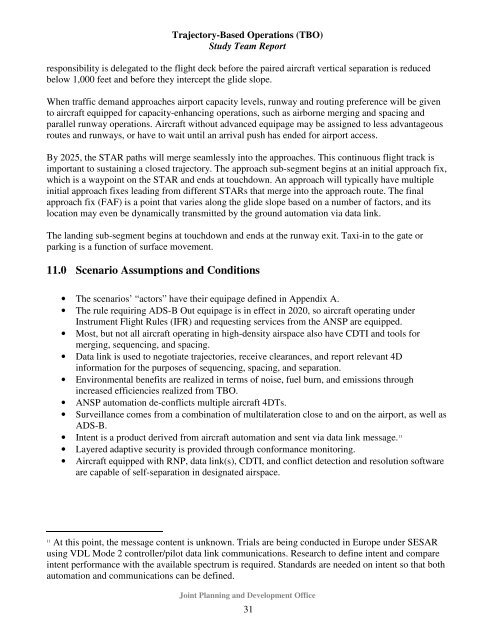Trajectory-Based Operations (TBO) - Joint Planning and ...
Trajectory-Based Operations (TBO) - Joint Planning and ...
Trajectory-Based Operations (TBO) - Joint Planning and ...
Create successful ePaper yourself
Turn your PDF publications into a flip-book with our unique Google optimized e-Paper software.
<strong>Trajectory</strong>-<strong>Based</strong> <strong>Operations</strong> (<strong>TBO</strong>)<br />
Study Team Report<br />
responsibility is delegated to the flight deck before the paired aircraft vertical separation is reduced<br />
below 1,000 feet <strong>and</strong> before they intercept the glide slope.<br />
When traffic dem<strong>and</strong> approaches airport capacity levels, runway <strong>and</strong> routing preference will be given<br />
to aircraft equipped for capacity-enhancing operations, such as airborne merging <strong>and</strong> spacing <strong>and</strong><br />
parallel runway operations. Aircraft without advanced equipage may be assigned to less advantageous<br />
routes <strong>and</strong> runways, or have to wait until an arrival push has ended for airport access.<br />
By 2025, the STAR paths will merge seamlessly into the approaches. This continuous flight track is<br />
important to sustaining a closed trajectory. The approach sub-segment begins at an initial approach fix,<br />
which is a waypoint on the STAR <strong>and</strong> ends at touchdown. An approach will typically have multiple<br />
initial approach fixes leading from different STARs that merge into the approach route. The final<br />
approach fix (FAF) is a point that varies along the glide slope based on a number of factors, <strong>and</strong> its<br />
location may even be dynamically transmitted by the ground automation via data link.<br />
The l<strong>and</strong>ing sub-segment begins at touchdown <strong>and</strong> ends at the runway exit. Taxi-in to the gate or<br />
parking is a function of surface movement.<br />
11.0 Scenario Assumptions <strong>and</strong> Conditions<br />
• The scenarios’ “actors” have their equipage defined in Appendix A.<br />
• The rule requiring ADS-B Out equipage is in effect in 2020, so aircraft operating under<br />
Instrument Flight Rules (IFR) <strong>and</strong> requesting services from the ANSP are equipped.<br />
• Most, but not all aircraft operating in high-density airspace also have CDTI <strong>and</strong> tools for<br />
merging, sequencing, <strong>and</strong> spacing.<br />
• Data link is used to negotiate trajectories, receive clearances, <strong>and</strong> report relevant 4D<br />
information for the purposes of sequencing, spacing, <strong>and</strong> separation.<br />
• Environmental benefits are realized in terms of noise, fuel burn, <strong>and</strong> emissions through<br />
increased efficiencies realized from <strong>TBO</strong>.<br />
• ANSP automation de-conflicts multiple aircraft 4DTs.<br />
• Surveillance comes from a combination of multilateration close to <strong>and</strong> on the airport, as well as<br />
ADS-B.<br />
• Intent is a product derived from aircraft automation <strong>and</strong> sent via data link message. 11<br />
• Layered adaptive security is provided through conformance monitoring.<br />
• Aircraft equipped with RNP, data link(s), CDTI, <strong>and</strong> conflict detection <strong>and</strong> resolution software<br />
are capable of self-separation in designated airspace.<br />
11<br />
At this point, the message content is unknown. Trials are being conducted in Europe under SESAR<br />
using VDL Mode 2 controller/pilot data link communications. Research to define intent <strong>and</strong> compare<br />
intent performance with the available spectrum is required. St<strong>and</strong>ards are needed on intent so that both<br />
automation <strong>and</strong> communications can be defined.<br />
<strong>Joint</strong> <strong>Planning</strong> <strong>and</strong> Development Office<br />
31
















